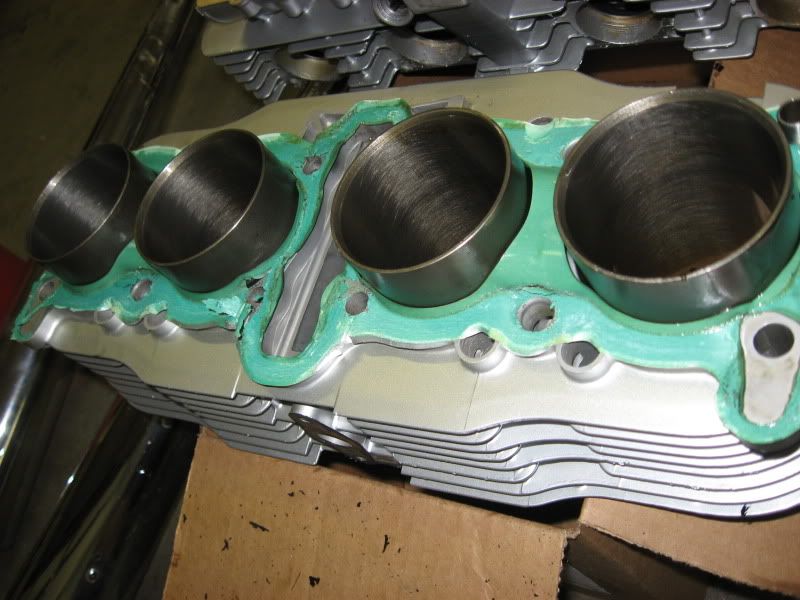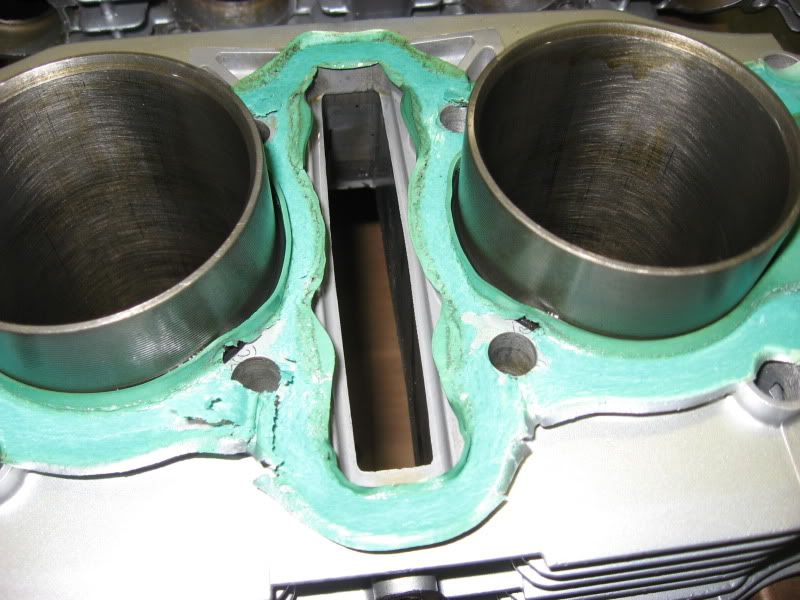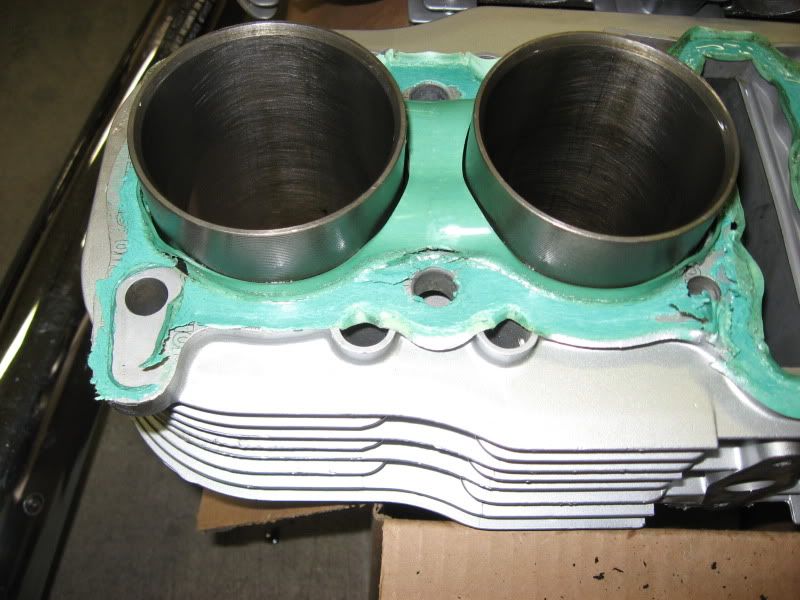Announcement
Collapse
No announcement yet.
Top End Noob
Collapse
X
-
 Guest repliedOK - trying to remove this cylinder is kicking my ass. That bastard will not budge.
Guest repliedOK - trying to remove this cylinder is kicking my ass. That bastard will not budge.
Tried tapping then whacking the damn thing with a rubber mallet. The rubber head split off the wooden handle (it was kind of old).
Cylinder - 1
Cinders - 0
Tried prying at different points, but there are not many spots that offer good purchase without risk of damage to a cooling fin. Where I could get a grip, screwdrivers and wrenches flexed without budging the beast.
Cylinder - 2
Cinders - 0
WTF is left? I'll pick up a new mallet and a prybar, but that approach seems hopeless. I have a heat gun, but that might cause uneven expansion of the metal, so I am loathe to try that.
I triple checked to make sure there is not some hidden fastener that I overlooked. Nothing.
Are there any solvents or other methods that will break the goddamn seal on this monster??
-
No, anti-size is different stuff.Originally posted by MisterCinders View PostThe manual says to coat the cams in SUZUKI MOLY PASTE. Is that just anti-seize compound?
You can get engine assembly lube at auto parts stores but you don't need it. Plain engine oil is fine for an engine with used cams and followers. Put some oil on the cam journals (under the cam caps that bolt to the head) and then fill up the pockets on the head with oil and you will be fine.
Leave a comment:
-
 Guest repliedThe manual says to coat the cams in SUZUKI MOLY PASTE. Is that just anti-seize compound?
Guest repliedThe manual says to coat the cams in SUZUKI MOLY PASTE. Is that just anti-seize compound?
Leave a comment:
-
Keep trying with the cylinder. I had the same problem getting it loose on one of my bikes but eventually it loosened after careful prying, and no fins were broken.
A bottle brush hone job shouldn't cost more than $30 or so, or buy your own hone from enginehones.com. The head shouldn't need any machine work unless it's warped or the gasket surface is corroded. Basscliff's web site has a valve removal tutorial if you need help.
Leave a comment:
-
 Guest repliedI am at a crossroads.
Guest repliedI am at a crossroads.
I pulled the head and installed the plug insert. The cylinder refuses to come off the engine. Tapping with a rubber mallet has no effect and there are no places to get a good purchase for prying the damn thing off. The gasket seal is so tight, that a razor won't get in there.
At first, I was tempted to reassemble and see how she runs, get some rides in, and otherwise postpone deeper exploration until later, perhaps through a shop.
A top-end rebuild, however, will cost about $400 - $500. So, my course of action is to return to the task of removing that cylinder, and possibly buying a replacement from eBay, should it not survive removal (there is already a small crack in one of the cooling fins).
Whether I replace the cylinder or not, I'll likely need to change piston rings and definitely need to hone the cylinders. I don't have the equipment for the hone job.
I also don't have the tools to remove the valves for inspection, though it looks like some home remedy tools might work from what I have seen on other threads. Even if I get the valves out, if they need any honing, I don't have the equipment.
I suppose that I could tear down the top end and get an estimate for the honing work from a shop. It should be much cheaper to get those discrete tasks done, without the added labor of tearing down and rebuilding the top end.
Does this make sense? Are there other approaches that I have overlooked?
TIA
Leave a comment:
-
 Guest repliedThreebond 1194 should be fine. You're not really using it as a sealant, just as a glue to hold the o-ring in place so it doesn't slip out and get pinched during the head installation.
Guest repliedThreebond 1194 should be fine. You're not really using it as a sealant, just as a glue to hold the o-ring in place so it doesn't slip out and get pinched during the head installation.
Leave a comment:
-
 Guest repliedOriginally posted by mike_of_bbg View PostYes it's good to use Threebond on that rectangular o-ring so it doesn't get out of place during the head installation (it's not really for "sealing" the o-ring per se). You want to let it set and get tacky. I've heard tales told too of people soaking them in hot water for a little while so they lose any natural curvature from the packaging.
Guest repliedOriginally posted by mike_of_bbg View PostYes it's good to use Threebond on that rectangular o-ring so it doesn't get out of place during the head installation (it's not really for "sealing" the o-ring per se). You want to let it set and get tacky. I've heard tales told too of people soaking them in hot water for a little while so they lose any natural curvature from the packaging.
Please do listen to Ed. Base gaskets are cheap. Perhaps my Athena head gasket would not have weeped oil if I'd used an OEM base gasket.
Which "Threebond" should I use. I have some 1194, but there is also a Threebond 1211. That matches the Clymer reference to "Suzuki Bond 1211." Should get a new tube of that stuff? Can I use what I have at hand?
Leave a comment:
-
I'm surprised Steve would gamble on the Athena base gasket since surely he's seen these photos and read all the bad reviews on these gaskets. If I was forced to use the Athena gaskets (including the base gasket) again I'd torque the head nuts to 25 ft-lbs and then live with a little oil weepage. Better than total failure.Originally posted by TheCafeKid View PostWith the Athena kits Ive used (and no long use) the biggest offender I found were the stud holes being cut just wrong. The base gasket/headgasket would want to buckle instead of sitting flat. The tear drop shaped Orings included for the oil passages around the studs I would also deem to be inferior as compared to OEM.
Having said that, I helped Steve rebuild his sons 850s top end with an Athena kit, and he just re-did his wifes 850s top end with an Athena kit.... No leaks that I am aware of...




Leave a comment:
-
 Guest repliedWith the Athena kits Ive used (and no long use) the biggest offender I found were the stud holes being cut just wrong. The base gasket/headgasket would want to buckle instead of sitting flat. The tear drop shaped Orings included for the oil passages around the studs I would also deem to be inferior as compared to OEM.
Guest repliedWith the Athena kits Ive used (and no long use) the biggest offender I found were the stud holes being cut just wrong. The base gasket/headgasket would want to buckle instead of sitting flat. The tear drop shaped Orings included for the oil passages around the studs I would also deem to be inferior as compared to OEM.
Having said that, I helped Steve rebuild his sons 850s top end with an Athena kit, and he just re-did his wifes 850s top end with an Athena kit.... No leaks that I am aware of...
Leave a comment:
-
 Guest repliedAwesome, thank you for all the quick replies =]
Guest repliedAwesome, thank you for all the quick replies =]
Leave a comment:
-
 Guest repliedYes it's good to use Threebond on that rectangular o-ring so it doesn't get out of place during the head installation (it's not really for "sealing" the o-ring per se). You want to let it set and get tacky. I've heard tales told too of people soaking them in hot water for a little while so they lose any natural curvature from the packaging.
Guest repliedYes it's good to use Threebond on that rectangular o-ring so it doesn't get out of place during the head installation (it's not really for "sealing" the o-ring per se). You want to let it set and get tacky. I've heard tales told too of people soaking them in hot water for a little while so they lose any natural curvature from the packaging.
Please do listen to Ed. Base gaskets are cheap. Perhaps my Athena head gasket would not have weeped oil if I'd used an OEM base gasket.
Leave a comment:
-
Just to add some meat and some confusion to Ed's post on Athena gaskets....
I would still use them.....in the UK. Maybe we've got different stock, I don't know, but I've not had any problems with them. On the other hand, Ed put a base gasket on his GS1000 and from the photos he posted I would suggest that you can buy better stuff for wiping your backside.
The gasket material is certainly different to OEM - which feels and looks more like very thin lino. Pass on what OEM costs over there - if the base gasket is only a tenner or so I'd buy one. If you've got rip off Britain spreading it's evil money grabbing ways I might also be tempted to buy the right gasket material and use your Athena one as a template.
Leave a comment:
-
The base gasket is the prime offender with the Athena gasket kit; the green gasket material can't take the clamp load of a cylinder head so it extrudes out of position under the cylinder. If you get a stock base gasket to supplement the Athena kit it might be worth the gamble. Just be sure to check the torque at regular intervals during engine break-in to make sure the head nuts are tight.Originally posted by MisterCinders View PostUgh, I just bought the Athena set.
IIRC, the Clymer instruction focuses on the O-Ring in the middle of the cylinder. That is where Clymer suggests using the 1211 Bond.Last edited by Nessism; 06-02-2011, 04:16 PM.
Leave a comment:
-
 Guest repliedUgh, I just bought the Athena set.
Guest repliedUgh, I just bought the Athena set.
IIRC, the Clymer instruction focuses on the O-Ring in the middle of the cylinder. That is where Clymer suggests using the 1211 Bond.
Leave a comment:
-
You do not need any sealer on the gaskets. I don't know why Clymer's suggests such as thing. And there has been lots of negative feedback about non-stock gaskets/seals. Suzuki gaskets are expensive, but far more reliable than non-stock gaskets such as Athena.Last edited by Nessism; 06-19-2011, 11:37 AM.
Leave a comment:
.png)
Leave a comment: